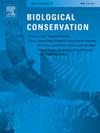Persistence of breeding philopatry and cultural memory of the Great Barrier Reef as a humpback whale breeding ground
IF 4.4
1区 环境科学与生态学
Q1 BIODIVERSITY CONSERVATION
引用次数: 0
Abstract
Long-distance seasonal migrations are a classic animal migration strategy and humpback whales (Megaptera novaeangliae) annually undertake some of the longest seasonal migrations of any mammal. Commercial whaling exploited their predictable migration and breeding/feeding site fidelity, which included the Australian east coast population (IWC Breeding Stock E1) that were almost extirpated due largely to legal whaling on their migratory route (1952–1962) and illegal whaling on their feeding ground (1959–61). An historical understanding of population demographics and fidelity to migration routes and breeding/feeding grounds is critical to assessing the recovery of exploited whale species, and informs an understanding of social learning of migratory routes and destinations. Here we present multiple lines of evidence, including cultural knowledge of First Nations Australians and observations near European arrival (1802), that demonstrates historical breeding philopatry by the E1 population to the Great Barrier Reef (GBR). Sightings within the GBR near the time of extirpation from commercial whaling (1965/67) provide evidence the whales' maintained their migration and retained ‘cultural memory’ of the breeding ground. We propose species evolutionary adaptations (e.g. song, reproductive aggregations) aided the species in minimising mate-finding Allee effects at low density at this time and speculate a temporal extension of the whales' breeding season at low abundance may have further maximised mate-finding opportunities. We present an analysis of contemporary aerial survey and satellite tracking data that supports consistent use of historical areas in the GBR, with implications on the welfare of whales from increased interactions with marine-based human activities.
大堡礁作为座头鲸繁殖地的繁殖理念和文化记忆的持久性
长距离季节性迁徙是典型的动物迁徙策略,座头鲸(Megaptera novaeangliae)每年都要进行哺乳动物中最长的季节性迁徙。商业捕鲸利用了它们可预测的迁徙和繁殖/进食地点的保真度,其中包括澳大利亚东海岸的种群(IWC繁殖种群E1),这些种群几乎灭绝,主要是由于在它们的迁徙路线上(1952-1962)的合法捕鲸和在它们的觅食地(1959-61)的非法捕鲸。对种群人口统计数据的历史了解以及对迁徙路线和繁殖/觅食地的忠实度对于评估被捕捞鲸鱼物种的恢复至关重要,并有助于了解迁徙路线和目的地的社会学习。在这里,我们提出了多种证据,包括第一民族澳大利亚人的文化知识和欧洲人到达(1802)时的观察,这些证据证明了E1种群对大堡礁(GBR)的历史繁殖哲学。在商业捕鲸活动即将灭绝的时期(1965/67),在GBR内的目击提供了鲸鱼保持迁徙并保留繁殖地的“文化记忆”的证据。我们提出,物种进化适应(例如鸣叫、生殖聚集)帮助该物种在此时低密度下最小化寻偶通道效应,并推测在低丰度下鲸鱼繁殖季节的时间延长可能进一步最大化寻偶机会。我们对当代航空调查和卫星跟踪数据进行了分析,这些数据支持在GBR中持续使用历史区域,并指出与海洋人类活动的互动增加对鲸鱼福利的影响。
本文章由计算机程序翻译,如有差异,请以英文原文为准。
求助全文
约1分钟内获得全文
求助全文
来源期刊

Biological Conservation
环境科学-环境科学
CiteScore
10.20
自引率
3.40%
发文量
295
审稿时长
61 days
期刊介绍:
Biological Conservation is an international leading journal in the discipline of conservation biology. The journal publishes articles spanning a diverse range of fields that contribute to the biological, sociological, and economic dimensions of conservation and natural resource management. The primary aim of Biological Conservation is the publication of high-quality papers that advance the science and practice of conservation, or which demonstrate the application of conservation principles for natural resource management and policy. Therefore it will be of interest to a broad international readership.
 求助内容:
求助内容: 应助结果提醒方式:
应助结果提醒方式:


